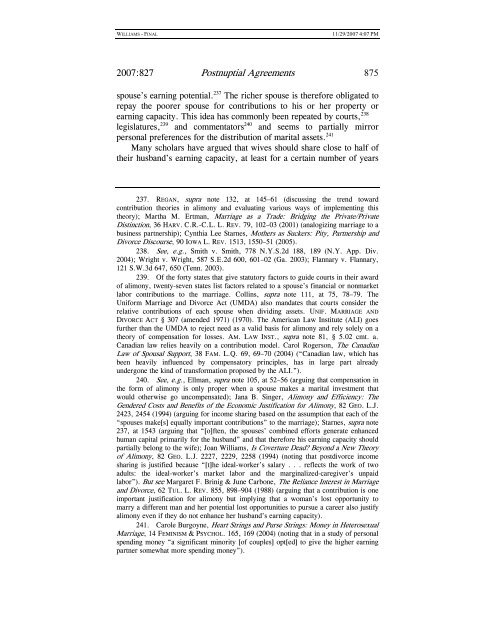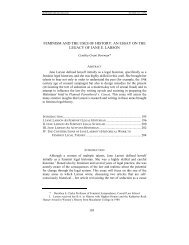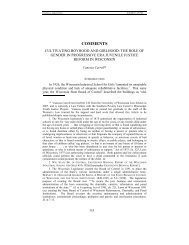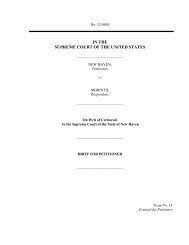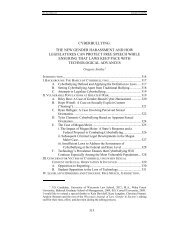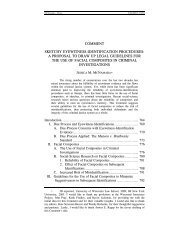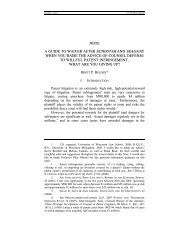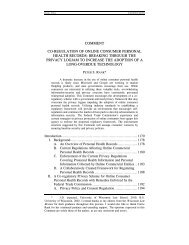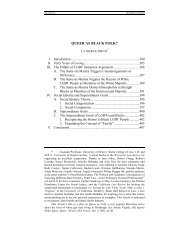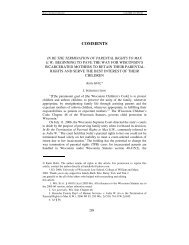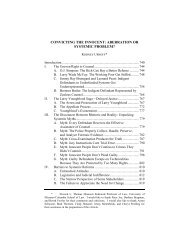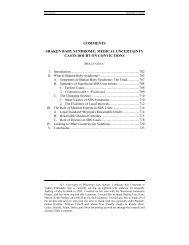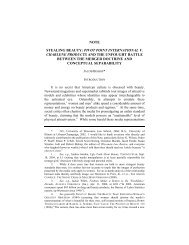POSTNUPTIAL AGREEMENTS - UW Law School
POSTNUPTIAL AGREEMENTS - UW Law School
POSTNUPTIAL AGREEMENTS - UW Law School
You also want an ePaper? Increase the reach of your titles
YUMPU automatically turns print PDFs into web optimized ePapers that Google loves.
WILLIAMS - FINAL 11/29/2007 4:07 PM<br />
2007:827 Postnuptial Agreements 875<br />
spouse’s earning potential. 237 The richer spouse is therefore obligated to<br />
repay the poorer spouse for contributions to his or her property or<br />
earning capacity. This idea has commonly been repeated by courts, 238<br />
legislatures, 239 and commentators 240 and seems to partially mirror<br />
personal preferences for the distribution of marital assets. 241<br />
Many scholars have argued that wives should share close to half of<br />
their husband’s earning capacity, at least for a certain number of years<br />
237. REGAN, supra note 132, at 145–61 (discussing the trend toward<br />
contribution theories in alimony and evaluating various ways of implementing this<br />
theory); Martha M. Ertman, Marriage as a Trade: Bridging the Private/Private<br />
Distinction, 36 HARV. C.R.-C.L. L. REV. 79, 102–03 (2001) (analogizing marriage to a<br />
business partnership); Cynthia Lee Starnes, Mothers as Suckers: Pity, Partnership and<br />
Divorce Discourse, 90 IOWA L. REV. 1513, 1550–51 (2005).<br />
238. See, e.g., Smith v. Smith, 778 N.Y.S.2d 188, 189 (N.Y. App. Div.<br />
2004); Wright v. Wright, 587 S.E.2d 600, 601–02 (Ga. 2003); Flannary v. Flannary,<br />
121 S.W.3d 647, 650 (Tenn. 2003).<br />
239. Of the forty states that give statutory factors to guide courts in their award<br />
of alimony, twenty-seven states list factors related to a spouse’s financial or nonmarket<br />
labor contributions to the marriage. Collins, supra note 111, at 75, 78–79. The<br />
Uniform Marriage and Divorce Act (UMDA) also mandates that courts consider the<br />
relative contributions of each spouse when dividing assets. UNIF. MARRIAGE AND<br />
DIVORCE ACT § 307 (amended 1971) (1970). The American <strong>Law</strong> Institute (ALI) goes<br />
further than the UMDA to reject need as a valid basis for alimony and rely solely on a<br />
theory of compensation for losses. AM. LAW INST., supra note 81, § 5.02 cmt. a.<br />
Canadian law relies heavily on a contribution model. Carol Rogerson, The Canadian<br />
<strong>Law</strong> of Spousal Support, 38 FAM. L.Q. 69, 69–70 (2004) (“Canadian law, which has<br />
been heavily influenced by compensatory principles, has in large part already<br />
undergone the kind of transformation proposed by the ALI.”).<br />
240. See, e.g., Ellman, supra note 105, at 52–56 (arguing that compensation in<br />
the form of alimony is only proper when a spouse makes a marital investment that<br />
would otherwise go uncompensated); Jana B. Singer, Alimony and Efficiency: The<br />
Gendered Costs and Benefits of the Economic Justification for Alimony, 82 GEO. L.J.<br />
2423, 2454 (1994) (arguing for income sharing based on the assumption that each of the<br />
“spouses make[s] equally important contributions” to the marriage); Starnes, supra note<br />
237, at 1543 (arguing that “[o]ften, the spouses’ combined efforts generate enhanced<br />
human capital primarily for the husband” and that therefore his earning capacity should<br />
partially belong to the wife); Joan Williams, Is Coverture Dead? Beyond a New Theory<br />
of Alimony, 82 GEO. L.J. 2227, 2229, 2258 (1994) (noting that postdivorce income<br />
sharing is justified because “[t]he ideal-worker’s salary . . . reflects the work of two<br />
adults: the ideal-worker’s market labor and the marginalized-caregiver’s unpaid<br />
labor”). But see Margaret F. Brinig & June Carbone, The Reliance Interest in Marriage<br />
and Divorce, 62 TUL. L. REV. 855, 898–904 (1988) (arguing that a contribution is one<br />
important justification for alimony but implying that a woman’s lost opportunity to<br />
marry a different man and her potential lost opportunities to pursue a career also justify<br />
alimony even if they do not enhance her husband’s earning capacity).<br />
241. Carole Burgoyne, Heart Strings and Purse Strings: Money in Heterosexual<br />
Marriage, 14 FEMINISM & PSYCHOL. 165, 169 (2004) (noting that in a study of personal<br />
spending money “a significant minority [of couples] opt[ed] to give the higher earning<br />
partner somewhat more spending money”).


